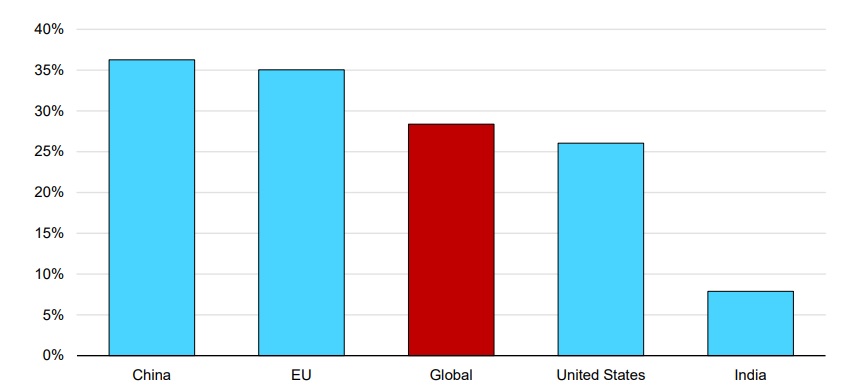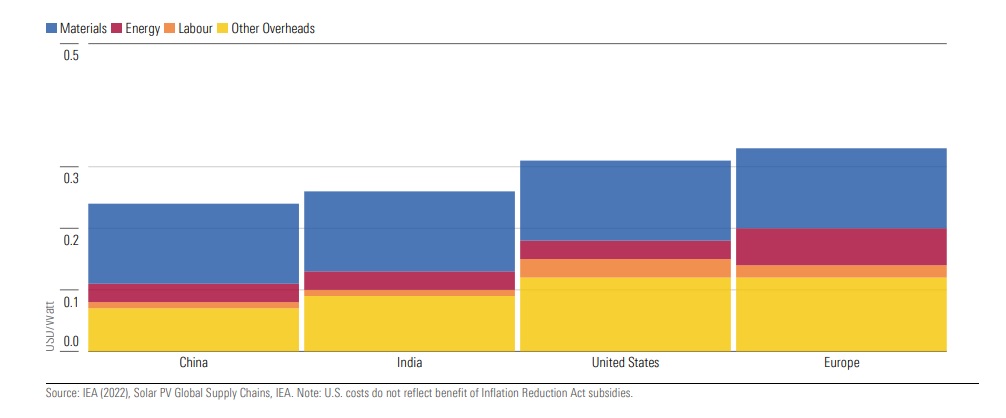
‘Arms race’ for clean energy allocations intensifies as Biden’s IRA pulls ahead
In the race for investors' renewables capital, the EU, China and the U.S. have rolled out ambitious clean energy investment programs. Despite the various initiatives, industry insiders agree Biden's IRA is "a tough offering to match"
The ongoing global competition for renewables investor capital, which has been compared to somewhat of an ‘arms race’, is increasingly intensifying between the U.S., Europe and China.
Particularly Europe and the U.S. seem to go after the same pool of investors, but Biden’s relatively young Inflation Reduction Act (IRA) is having such a near-unprecedented appeal on investors that more and more investors are turning to the U.S. clean energy market.
Moreover, high inflation, mounting costs and red tape are not doing the European investment climate for renewables any favours.
In fact, the complex market conditions in Europe are slowly starting to bite as they are impacting the investment decisions of some multi-billion pound sector players.
Swedish industry giant Vattenfall cancelled a large offshore wind project off the coast of the UK in August, explaining the project was no longer attractive to investors as input costs had skyrocketed by more than 40%.
The state-owned company explained that rising gas prices, high inflation and rapidly increasing costs had led to the decision to cancel the project altogether. The move sent shockwaves through the European clean energy space.
Momentum
The energy crisis triggered by Russia’s invasion of Ukraine has sparked unprecedented momentum for renewables.
Fossil fuel supply disruptions have underlined the energy security benefits of domestically generated renewable electricity, leading many countries to strengthen policies supporting renewable investments.
Net Zero Investor's Annual Conference | 11th December 2023 | London
Meanwhile, higher fossil fuel prices worldwide have improved the competitiveness of solar PV and wind generation against other fuels.
As a result, renewable capacity expansion in the next five years will be much faster than what was expected just a year ago.
Over 2022-2027, renewables are expected to grow to almost 2 400 GW, according to a recent forecast by the International Energy Agency (IEA), which stressed that this “is equal to the entire installed power capacity of China today.”
It is an 85% acceleration from the previous five years, and almost 30% higher than what was forecast last year, making it the IEA’s largest ever upward revision, with renewables set to account for over 90% of global electricity capacity expansion over the forecast period.
"Renewables will transform the global power mix through 2027. They are the only electricity generation source whose share is expected to grow, with declining shares for coal, natural gas, nuclear and oil generation."

Regional investment initiatives
The upward revision is mainly driven by China, the EU, the U.S. and India, which are all implementing existing policies and regulatory and market reforms, while also introducing new ones more quickly than expected in reaction to the energy crisis.
“Renewables will transform the global power mix through 2027. They are the only electricity generation source whose share is expected to grow, with declining shares for coal, natural gas, nuclear and oil generation," said Heymi Bahar, a senior analyst at the IEA.
Bahar stressed that “global renewable capacity can expand by an additional 25% compared with the main forecast if countries address policy, regulatory, permitting and financing challenges.”
Three relatively new frameworks have therefore become crucial into attracting asset owner capital: China’s 14th Five-Year Plan and market reforms, the REPowerEU plan and the U.S. Inflation Reduction Act are all designed to speed up investments in clean energy.

IRA
At first glance, it would be hard to know from its rather generic title that the Inflation Reduction Act (IRA) contains the largest package of government support for the energy transition offered by any country in the world.
President Biden’s landmark legislation, which was passed last year, has set hares running across the globe, particularly in the EU.
Vice President and EU competition commissioner Margrethe Vestager has said that part of the IRA is “a threat to the competitiveness of specific key sectors for the green transition of the European industry”.
In turn, the European Commission announced its Green Deal Industrial Plan and proposed easing restrictions on State aid for investments in renewable energy or decarbonising industry.
“The IRA is a tough offering to match,” remarked Isabel Taylor, a London-based partner at international law firm Slaughter and May.
She pointed out Biden's flagship framework contains a $369 billion green support package intended to support green infrastructure and attract clean energy businesses to the U.S., $216bn of which is earmarked for corporations.
In addition, the law gives tax incentives to businesses across a range of green investment projects, including wind and solar farms, battery storage facilities and investments in renewable hydrogen.
"The IRA is a tough offering to match."

The IRA also contains incentives to ‘buy American’, which could lead to a long-term restructuring of supply chains, Taylor stressed.
For example, for an electric vehicle to qualify for its $7,500 tax credit, all its battery components will soon need to be made in North America.
“The EU does not have a free trade agreement with the U.S. meaning tariffs already apply to EU goods entering the U.S.; ‘buy American’ measures like this therefore put EU-made products at a disadvantage on the US market by making EU products comparatively more expensive,” Taylor explained.
European Green Deal
The European Commission’s REPowerEU plan, released in May 2022, proposed ending the bloc’s reliance on Russian fossil fuels by 2027. Its Green Deal proposals are designed to attract fresh investor capital into the renewables space.
“Many European countries passed or proposed action plans to further raise their ambitions, increased policy support and addressed non-financial challenges,” Bahar said.
IEA’s forecast for growth in the EU has been revised upward by 30% from last year’s report, led by Germany (50% higher) and Spain (60% higher).
"Germany has increased renewable electricity targets, introduced higher auction volumes and improved remuneration for distributed PV while reducing permitting timelines," Bahar said, while "Spain has streamlined permitting for solar PV and wind plants, and increased grid capacity for new renewable energy projects."
However, the EU package does not quite match the U.S. financially, offering €250bn in financing that Member States can use to offer subsidies and tax breaks.
"It is important that any proposals be carefully and transparently prepared, with clear visibility on timing and involving all relevant stakeholders, in order to avoid unintended uncertainty among investors,” Bahar said.
He stressed China, the U.S. and India will all double their renewable capacity expansion in the next five years, accounting for two-thirds of global growth.
Also read
Why floating offshore wind could be the next frontier in renewables
China
China alone is forecast to install almost half of new global renewable power capacity over 2022-2027, as growth accelerates in the next five years despite the phaseout of wind and solar PV subsidies.
Policy guidelines and targets in China’s new 14th Five-Year Plan on renewable energy are the basis for this year’s 35% upward revision on last year’s forecast.
Despite growing investment in the United States and India, China is forecast to invest $90 billion in the next five years, more than triple the expected investment by the rest of the world combined.
“Very ambitious new renewable energy targets, market reforms and strong provincial government support provide long-term revenue certainty for renewables," Taylor noted.
In most Chinese provinces, utility-scale renewables are cheaper than regulated coal electricity prices, driving rapid adoption.
"The Inflation Reduction Act has made the U.S. more competitive than Europe for the development of renewables."

U.S. pulling ahead, for now
For now, it seems the increasingly intense ‘arms race’ is being won by Biden's IRA.
In fact, industry experts warn Europe may be losing out to clean energy capital as money flows are clearly directed towards the U.S.
Europe may lead the world in renewable energy adoption, but headwinds are forming that could impede further progress, risking its recently increased target of renewable energy comprising 42.5% of total energy demand by 2030, warned Tancrede Fulop, a senior equity analyst at Morningstar.
''The ramp-up of renewables over the last decade that granted to Europe its leadership position was propelled by two tailwinds: falling interest rates and construction costs,” he explained.
“Since the end of 2021, these tailwinds have reversed and become obstacles,” Fulop continued.
“In addition, the Inflation Reduction Act has made the U.S. more competitive than Europe for the development of renewables,” he said.
Costs are increasingly a crucial factor to consider for any investor scrutinising the potential in different key markets.
While China and the U.S. have managed to keep renewables costs relatively competitive, Europe is now considered expensive by many investors looking to break into or grow their renewable investment portfolio.

What complicates matters even further is permit delays for renewable projects as they are further risking renewable energy targets with Europe having some of the longest permit times in the world and is well above its own standard.
“Global inflation and higher rates are the most notable as both substantially increase costs, which threaten future and current project development, particularly offshore wind,” he said.
“These are compounded by continued permit delays throughout Europe while the introduction of greater subsidies makes the U.S. a more appealing place to invest," Fulop noted.
"If the world’s major powers get caught up in jostling for position as a subsidy leader, there is a risk that they could lose sight of the fact that net zero is not a zero sum game."
Subsidies
Finally, there is one more issue that keeps impacting the investment market, some would even speak of an outright distortion: EU subsidies and state aid.
In Europe, the competition rules in the Treaty on the Functioning of the EU place restrictions on the grant of State aid to control the risk that financial or other assistance from the State, or other public funds, operates to disrupt normal competitive forces and threaten the EU’s internal market objectives.
The EC considers the control of State aid as one of the most important aspects of EU competition policy.
However, “crises like the 2007-2008 financial crisis, the Covid-19 pandemic and the Russian war against Ukraine have seen the EC apply the State aid rules in a way that allows EU Member States to respond flexibly to these challenges,” Taylor said.
“The EC is now using this approach to deal with the climate crisis.”
She noted that “some may say that this global competition of governments to support green investment can only be a good thing for our planet. The additional cost of using a product or service powered by clean energy is often a significant barrier to scaling up the energy transition.”
Taylor agreed this is an issue government subsidies could address, particularly when new technologies are in their infancy.
However, “there has been opposition within the EU to the EC’s proposals because of the destabilising effect relaxing State aid rules could have on the bloc.”
Some 11 Member States, including Ireland, Poland, the Netherlands, Hungary, Czechia and Denmark, have reportedly advised the EC to exercise "great caution" when loosening State aid rules, arguing that the harms these changes risk within the Union itself could be “greater than the positive effects”.
France and Germany - the EU’s two biggest economies - account for almost 80% of the State aid.
“If the world’s major powers get caught up in jostling for position as a subsidy leader, there is a risk that they could lose sight of the fact that net zero is not a zero sum game,” Taylor concluded.
Also read
Asset owners turn greener worldwide but dark clouds are gathering fast




